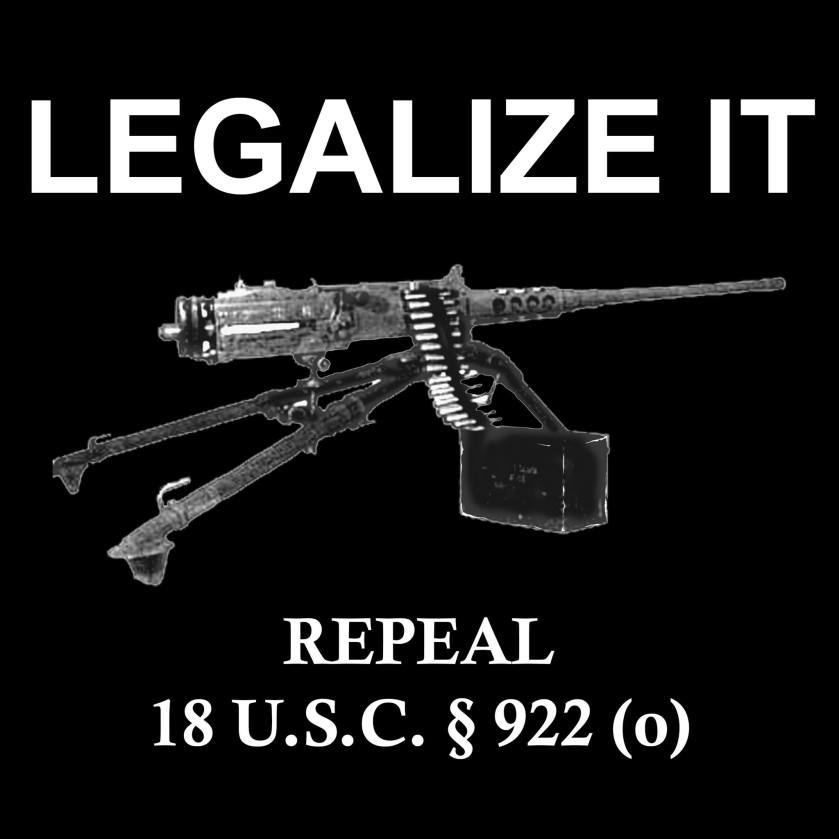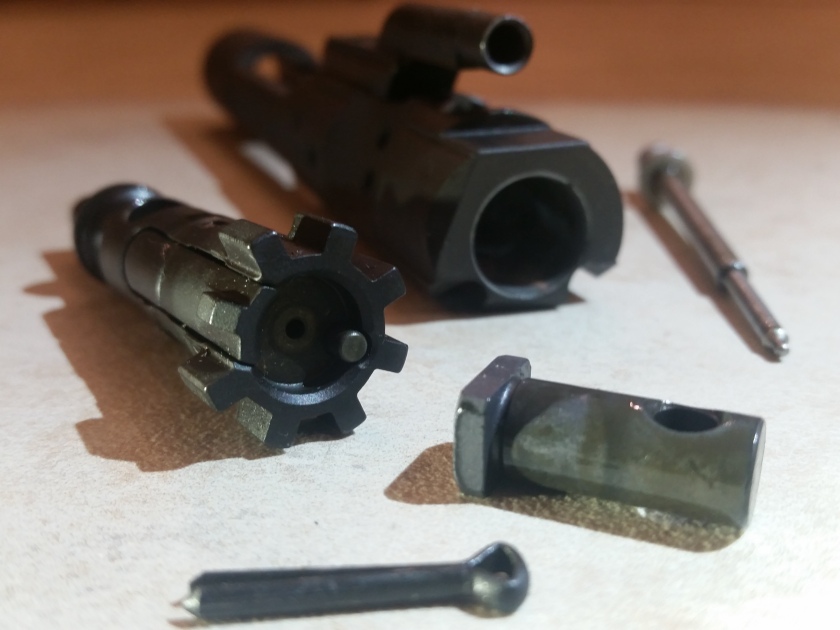
Background of 18 U.S.C. § 922(o) as it concerns Hollis v. Lynch.
As of this posting, Hollis v. Lynch (formerly Hollis v. Holder) is an ongoing case against the U.S. Attorney General with the goal of judicially upending 18 U.S.C. § 922(o), commonly referred to as the ’86 Machine Gun ban. To have an appreciation for the importance of this case, you first have to gain some historical context on the laws governing the possession and transfer of machine guns.
In 1934, Congress passed the National Firearms Act in response to gang violence during the prohibition era. The 1934 NFA did not result in a ban, but rather severe restrictions on machine guns, silencers and other firearms. The restrictions included submission of finger prints, photographs, approval of local law enforcement, and a $200 tax for any citizen seeking to obtain NFA-regulated items. Due to the lengthy process and relative obscurity of the law, most Americans are still simply unaware of the path to legal machine gun ownership and assume that possessing them is illegal. The rise of the Internet has helped tremendously in dispelling that myth, but there are still millions who simply believe machine guns “are illegal”.
Indeed, machine guns are very difficult to obtain presently. But this is not due to the NFA, but rather an obscure amendment to a federal firearms law passed in the 1980s that later caused the market value of machine guns to sky rocket. In 1985, Senator James McClure, a Republican from Idaho, introduced the Firearm Owners Protection Act to combat the Bureau of Alcohol, Tobacco, Firearms, and Explosives’ abusive practice of prosecuting otherwise lawful citizens with federal gun charges. For the most part, this act was a net gain for lawful gun owners. However, on April 10th, 1986 when the FOPA was up for debate on the floor of the House of Representatives, Representative William Hughes, a New Jersey Democrat, offered an amendment aimed at killing the bill. House Amendment 777 to H.R. 4332, now infamously referred to as the “Hughes Amendment”, amended Chapter 18 of the U.S. Code, section 922 to add subsection “o”, reading:
(1) Except as provided in paragraph (2), it shall be unlawful for any person to transfer or possess a machinegun.
(2) This subsection does not apply with respect to—
(A) a transfer to or by, or possession by or under the authority of, the United States or any department or agency thereof or a State, or a department, agency, or political subdivision thereof; or
(B) any lawful transfer or lawful possession of a machinegun that was lawfully possessed before the date this subsection takes effect.
The Democrats added this language as poison pill, and it was defeated when initially brought to a full vote. Nevertheless, Senate Democrats adopted the House version of the FOPA, complete with the Hughes Amendment, and the bill was signed by Ronald Reagan on May 19, 1986. Many mistakenly claim that President Reagan “sold out” gun owners by signing this bill, however it is important to note that many of the things taken for granted today were extremely difficult, if not impossible, before the Firearm Owners Protection Act. The 1968 Gun Control Act, forming the bulwark of federal gun laws, made the simple acts of interstate travel with a firearm or the mail-order of ammunition excruciatingly difficult, if not impossible. Coupled with the BATFE’s abusive practices, the FOPA was necessary to ensure American’s could continue exercising their Second Amendment rights, albeit at the loss of new-production machine guns. Therein lies the irony of 922(o); like the NFA before it, 922(o) did not ban all machine guns. It banned machine gun production and sales after May 19, 1986. Machine guns owned before that date were grandfathered, and remain legal today.
The grandfathering of pre-86 machineguns begs the question: If machineguns are such a menace to society, why weren’t all of them banned in 1986? Prior to the 1986 ban, there is no record of any murders committed with legally-owned machine guns. After the ban went into effect, there were two murders committed with legally-owned machine guns; one by a police officer in 1988 and another by a physician in 1993. According to the FBI’s statistics on violent crime, over 1,500 murders were committed in 2014 alone with knives. To further emphasize, there were 780 times the amount of murders committed with knifes in a single year than there were with NFA register machineguns in the last 30 years. The ’86 ban serves no useful purpose, as there is simply no inherent danger in private citizens possessing them.
Seeing as there is no real reason behind the ban other than to frustrate the Second Amendment rights of regular Americans, we’ll take a look at the draconian effects it has had on firearms commerce. Since the supply of civilian-legal machine guns is frozen at May 1986 levels, there is an artificial scarcity. This has predictably ballooned transferable machinegun values to dozens and in some case hundreds of times what the market value would be if new production were permitted. At the time of this post, a Colt AR15 A4 has a MSRP of $999. A pre-86 transferable Colt M16 (identical to the AR15 except for the fact it has a selectable automatic fire mode) can command up to $30,000 or more at auction. Pre-86 transferable belt-fed machine guns can reach $50,000 and higher depending on the model and condition. While the basic economic principles of supply, demand, and voluntary exchange should always be respected, it is worth repeating that machine gun values would not be what they are today without government interference.
It’s also important to note that the ban does not affect federal and state governments. A reasonable person could conclude “of course it doesn’t affect the government, how would the military have the weapons needed for duty?” but that’s not quite the whole story. In 2014, CNN reported that the U.S. Department of Agriculture purchased 85 submachine guns. The agency tasked with overseeing federal policy on the quality of crops and livestock has its own enforcement department, armed with machine guns. USDA’s machine gun ownership isn’t unique either. The Environmental Protection Agency has approximately 200 “special agents” charged with enforcing federal environmental regulations. These agents are typically armed with machine guns and other implements you would expect to see reserved for police SWAT teams. In 2010, the U.S. Department of Education purchased several shotguns with 14” barrels. While not machine guns, those shotguns would still be subject to the same NFA regulations as machine guns if a private citizen wished to purchase them, due to the short length of their barrels, but the Education Department gets a pass because they are a federal agency. The fact is, the law doesn’t just exempt military and law enforcement agencies, but any agency within the government tasked with the slightest policy enforcement role. It creates a scheme of “laws for me, and laws for thee” in which the “King’s men” enjoy rights that the general public is denied.
This is the legacy of 18 U.S.C. § 922(o); legal machine gun ownership for the wealthy, the well connected, and the government, and a contemptible view of ordinary, lawful gun owners. With even some of the most basic machine guns costing well over several thousand dollars, what should be a utility item attainable by the common man is now a luxury item for only those with the resources to attain it. This statement in no way condemns legal machine gun owners, it is merely an acknowledgement of the end result of rampant government interference.
The next part in this series will focus on the circumstances surrounding the initial push toward Hollis v. Lynch. Thank you for reading and thank you for supporting Gun and Pen!








